Expression Profiles of Digestive Genes in the Gut and Salivary Glands of Tarnished Plant Bug (Hemiptera: Miridae)
- PMID: 33974083
- PMCID: PMC8112305
- DOI: 10.1093/jisesa/ieab028
Expression Profiles of Digestive Genes in the Gut and Salivary Glands of Tarnished Plant Bug (Hemiptera: Miridae)
Abstract
Host plant preference of agricultural pests may shift throughout the growing season, allowing the pests to persist on wild hosts when crops are not available. Lygus Hahn (Hemiptera: Miridae) bugs are severe pests of cotton during flowering and fruiting stages, but can persist on alternative crops, or on weed species. Diversity of digestive enzymes produced by salivary glands and gut tissues play a pivotal role in an organism's ability to utilize various food sources. Polyphagous insects produce an array of enzymes that can process carbohydrates, lipids, and proteins. In this study, the digestive enzyme repertoire of the tarnished plant bug, Lygus lineolaris (Palisot de Beauvois), was identified by high-throughput sequencing followed by cDNA cloning and sequencing. This study identified 87 digestive genes, including 30 polygalacturonases (PG), one β-galactosidase, three α-glucosidases, six β-glucosidases, 28 trypsin-like proteases, three serine proteases, one apyrase-like protease, one cysteine protease, 12 lipases, and two transcripts with low similarity to a xylanase A-like genes. RNA-Seq expression profiles of these digestive genes in adult tarnished plant bugs revealed that 57 and 12 genes were differentially expressed in the salivary gland and gut (≥5-fold, P ≤ 0.01), respectively. All polygalacturonase genes, most proteases, and two xylanase-like genes were differentially expressed in salivary glands, while most of the carbohydrate and lipid processing enzymes were differentially expressed in the gut. Seven of the proteases (KF208689, KF208697, KF208698, KF208699, KF208700, KF208701, and KF208702) were not detected in either the gut or salivary glands.
Keywords: RNA-Seq; digestive enzyme; expression profile; salivary gland; tarnished plant bug.
Published by Oxford University Press on behalf of Entomological Society of America 2021.
Figures
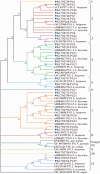
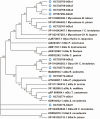
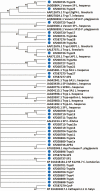


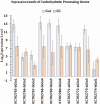
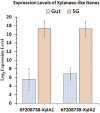

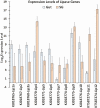
Similar articles
-
Identification of Genes Potentially Responsible for extra-Oral Digestion and Overcoming Plant Defense from Salivary Glands of the Tarnished Plant Bug (Hemiptera: Miridae) Using cDNA Sequencing.J Insect Sci. 2016 Jun 20;16(1):60. doi: 10.1093/jisesa/iew041. Print 2016. J Insect Sci. 2016. PMID: 27324587 Free PMC article.
-
Expression and RNA interference of salivary polygalacturonase genes in the tarnished plant bug, Lygus lineolaris.J Insect Sci. 2010;10:173. doi: 10.1673/031.010.14133. J Insect Sci. 2010. PMID: 21062205 Free PMC article.
-
Molecular cloning of trypsin-like cDNAs and comparison of proteinase activities in the salivary glands and gut of the tarnished plant bug Lygus lineolaris (Heteroptera: Miridae).Insect Biochem Mol Biol. 2003 Sep;33(9):889-99. doi: 10.1016/s0965-1748(03)00094-8. Insect Biochem Mol Biol. 2003. PMID: 12915180
-
Biology, Ecology, and Pest Management of the Tarnished Plant Bug, Lygus lineolaris (Palisot de Beauvois) in Southern Row Crops.Insects. 2021 Sep 9;12(9):807. doi: 10.3390/insects12090807. Insects. 2021. PMID: 34564247 Free PMC article. Review.
-
Establishing an IPM System for Tarnished Plant Bug (Hemiptera: Miridae) in North Carolina.Insects. 2025 Feb 5;16(2):164. doi: 10.3390/insects16020164. Insects. 2025. PMID: 40003795 Free PMC article. Review.
Cited by
-
Exploration of Protease Resources in the Gut of Omnivorous Gryllotalpa orientalis (Orthoptera: Gryllotalpidae).Biology (Basel). 2024 Aug 23;13(9):650. doi: 10.3390/biology13090650. Biology (Basel). 2024. PMID: 39336078 Free PMC article.
-
High-quality chromosome-level scaffolds of the plant bug Pachypeltis micranthus provide insights into the availability of Mikania micrantha control.BMC Genomics. 2023 Jun 20;24(1):339. doi: 10.1186/s12864-023-09445-8. BMC Genomics. 2023. PMID: 37340339 Free PMC article.
-
De Novo Transcription Responses Describe Host-Related Differentiation of Paracoccus marginatus (Hemiptera: Pseudococcidae).Insects. 2022 Sep 19;13(9):850. doi: 10.3390/insects13090850. Insects. 2022. PMID: 36135551 Free PMC article.
-
A chromosome scale assembly of the tarnished plant bug, Lygus lineolaris (Palisot de Beauvois), genome.BMC Res Notes. 2023 Jun 27;16(1):125. doi: 10.1186/s13104-023-06408-w. BMC Res Notes. 2023. PMID: 37370172 Free PMC article.
References
-
- Allen, M. L. 2007. Expressed sequenced tags from Lygus lineolaris (Hemiptera: Miridae), the tarnished plant bug. Genet. Mol. Res. 6: 206–213. - PubMed
-
- Allen, M. L., and W. B.Walker, 3rd. 2012. Saliva of Lygus lineolaris digests double stranded ribonucleic acids. J. Insect Physiol. 58: 391–396. - PubMed
-
- Almagro Armenteros, J. J., Tsirigos K. D., Sønderby C. K., Petersen T. N., Winther O., Brunak S., von Heijne G., and Nielsen H.. . 2019. SignalP 5.0 improves signal peptide predictions using deep neural networks. Nat. Biotechnol. 37: 420–423. - PubMed
MeSH terms
LinkOut - more resources
Full Text Sources
Other Literature Sources

